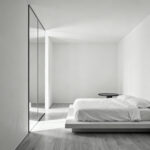Your bedroom isn’t just a room; it’s your personal sanctuary where you retreat to recharge, dream, and escape the chaos of daily life. I’ve seen so many people treat their bedrooms as an afterthought, focusing their decorating energy on spaces guests will see. But here’s the thing – you deserve a beautiful space that’s all your own!
Ready for a change? I’ve pulled together 19 dreamy bedroom design ideas that will help you create a space you’ll absolutely adore. As someone who’s spent years helping budget-conscious homeowners transform their spaces, I promise these ideas won’t break the bank. Let’s dive in and discover how to create the bedroom of your dreams!
1. Let the Light In: Maximize Natural Light for a Bright Bedroom
Natural light is a game-changer in bedrooms. I can’t tell you how many drab, lifeless spaces I’ve seen transformed with just a few tweaks to window treatments. Natural light boosts your mood, regulates your sleep cycle, and makes your space feel larger and more inviting. Plus, there’s nothing better than waking up to sunshine filtering through your windows rather than being jolted awake by an alarm.

If your bedroom feels cave-like, start by addressing common light blockers. Small windows, heavy curtains that stay closed, overgrown trees outside, and even dark wall colors can all limit the light. For an immediate difference, swap heavy drapes for sheer curtains or adjustable blinds that filter light while maintaining privacy. Clean your windows regularly (you’d be shocked how much dirt builds up!), and consider a larger window or skylight if your budget allows.
Here’s where it gets interesting – the right window treatments aren’t just functional; they’re transformative. I once helped a client replace blackout curtains with layered sheers and light-filtering blinds, and she couldn’t believe it was the same room!
2. Curl Up in Comfort: Design a Dreamy Reading Nook in Your Bedroom
Who hasn’t dreamed of having their own cozy corner to escape into a good book? A reading nook adds purpose to unused bedroom space while creating a mini-retreat within your sanctuary. When I create reading nooks for clients, I focus on four key elements: comfortable seating (think plush armchairs or window seats with cushions), proper lighting (both ambient and task), a small surface for your tea and books, and soft textures like throw blankets and pillows.

Small bedrooms present a challenge, but they’re not deal-breakers for creating a reading nook. Use vertical space with floating shelves above a chair, consider a window seat with storage underneath, or even a simple floor cushion with books artfully arranged nearby. Wall-mounted reading lamps save valuable floor space and provide focused light exactly where you need it. Remember, scale matters – choose furniture that fits your space without overwhelming it.
The heart of the matter is that lighting can make or break your reading nook. Layer ambient lighting for overall glow with task lighting aimed directly at your reading material. Position your nook near a window for daytime reading, then supplement with adjustable lamps for evening use. This thoughtful approach creates a nook that’s functional morning to night.
3. Bring the Outdoors In: Infuse Your Bedroom with Refreshing Greenery
I’ve watched people’s faces light up when they see how a few strategically placed plants can transform a bedroom. Plants aren’t just decorative; they’re natural air purifiers that filter toxins while reducing stress and improving mood. In a space dedicated to rest, these benefits are priceless. Even if you don’t have a green thumb, there are plenty of low-maintenance options that thrive in bedroom conditions.

For bedroom-friendly plants, focus on varieties that are easy-care and air-purifying. My go-to recommendations include:
- Snake plants – Nearly indestructible and excellent air purifiers
- Pothos – Trailing vines that tolerate low light
- ZZ plants – Drought-tolerant and glossy
- Peace lilies – Beautiful flowers and great air cleaners
- Spider plants – Non-toxic and perfect for hanging baskets
The tricky part is balancing the benefits with potential drawbacks. Some people may experience allergies to certain plants, and overwatering can lead to mold issues. Ensure good ventilation and research each plant’s specific needs. I always recommend starting with just one or two plants to see how they affect your space and sleep quality before creating a full bedroom jungle.
4. Less is More: Embrace Minimalist Design for a Serene Bedroom Space
After years of helping people declutter their bedrooms, I can tell you firsthand: minimalism works wonders for sleep quality. A minimalist bedroom focuses on intentionality – keeping only essential furniture with clean lines, eliminating clutter, and embracing a neutral color palette. The goal isn’t a cold, empty space but rather a calming sanctuary free from visual noise and distractions.

The connection between minimalism and better sleep is powerful. When you remove excess stuff, you reduce visual stimulation that can trigger anxiety and make it difficult to wind down. Your brain literally has less to process, creating mental space for relaxation. I’ve had clients report falling asleep faster and waking less frequently after simplifying their bedrooms.
Do you see how huge that is? Instead of spending money on sleep aids or new mattresses, sometimes the solution is simply removing what doesn’t need to be there. The key is finding balance – create a space that feels intentionally designed rather than empty, comfortable rather than stark. This approach to bedroom design ideas focuses on quality over quantity.
5. Make a Statement: Transform Your Bedroom with a Bold Accent Wall
Sometimes a single design element can completely transform your space. An accent wall creates a focal point that draws the eye and adds instant personality to your bedroom. The best accent walls complement your existing decor while adding visual interest without overwhelming the space. I love accent walls because they’re budget-friendly – you’re only treating one surface instead of the entire room.

When choosing your accent wall approach, consider these popular options: – Paint in a bold or contrasting color – Wallpaper with patterns or textures – Wood paneling or shiplap – Exposed brick (real or veneer) – Fabric panels for softness and sound absorption
What complicates this is getting the balance right. The wall behind your headboard is typically ideal for an accent treatment since it’s already a natural focal point. Proper preparation is crucial – clean the wall thoroughly, patch imperfections, and use primer before painting. For wallpaper, accurate measurements prevent frustrating shortages or misalignments.
My breakthrough came when I realized accent walls don’t have to be complicated to be effective. One of my favorite budget bedroom design ideas was helping a teacher create a geometric accent wall using just painter’s tape and two shades of the same color. The subtle pattern added dimension without overwhelming her small space.
6. Layer Up the Luxury: Indulge in Textural Richness for a Cozy Bedroom
Our sense of touch is deeply connected to feelings of comfort and security. That’s why textural richness is essential for creating a truly inviting bedroom. Different textures stimulate our senses and create a more immersive environment than flat, uniform surfaces. Think about how it feels to sink into a velvet chair versus sitting on a hard wooden stool – texture makes all the difference!

For a luxurious bedroom, mix contrasting yet complementary materials. Some of my favorite combinations include:
- Velvet pillows against crisp cotton sheets
- Chunky knit throws over smooth linen duvets
- Faux fur rugs on hardwood floors
- Smooth wooden nightstands with brass accents
- Tufted headboards with silky lampshades
It works something like this: start with a neutral base and gradually layer textures in varying shades and materials. Consider scale – use larger textures on bigger items like bedspreads and smaller textures on accessories. Pay attention to your color palette to ensure your textural elements work together harmoniously.
I once transformed a client’s stark, uninviting bedroom by simply adding textural elements. The room had good bones but felt cold and unwelcoming. By introducing a plush area rug, a tufted headboard, and layers of different textiles, the space became instantly cozier without changing the color scheme or furniture layout.
7. Cleverly Concealed: Optimize Storage Solutions for a Clutter-Free Bedroom
Visual clutter is the enemy of relaxation. That’s why concealed storage is vital for creating a peaceful bedroom sanctuary. When everyday items are hidden away, your space feels more serene and organized, promoting both physical and mental relaxation. Plus, good storage maximizes usable space, making even small bedrooms feel larger and less cramped.

Look for storage opportunities in unexpected places. Under-bed drawers utilize otherwise wasted space. Headboards with built-in shelves or compartments add function without footprint. Ottoman benches at the foot of the bed provide seating and hidden storage. Even walls can work harder with recessed shelving or hidden cabinets.
Here’s what happened when I helped a client with minimal closet space: we installed floating nightstands with drawers instead of traditional tables, added an upholstered storage bench, and replaced her solid headboard with one featuring hidden compartments. The room suddenly felt twice as spacious because everything had a place to hide away. These bedroom design ideas prove that practical solutions can still be beautiful.
8. Add a Sparkle of Glamour: Introduce Metallic Accents for a Chic Bedroom
A touch of metallic shimmer can elevate a bedroom from ordinary to extraordinary. Metallics reflect light, creating depth and sophistication that flat finishes can’t match. Each metallic tone creates a different mood – gold adds warmth and opulence, silver offers contemporary coolness, bronze and copper bring vintage charm, while rose gold blends femininity with modern edge.

The key to using metallics effectively is balance and restraint. Instead of going overboard, incorporate them strategically through:
- Lamp bases or pendant lighting
- Picture frames or mirror frames
- Decorative trays on nightstands
- Drawer pulls or cabinet hardware
- Subtle threads in throw pillows or bedding
Let me paint you a picture of how this works in real life. I helped a client transform her plain bedroom by adding brass reading lamps, a gold-framed mirror, and copper-edged picture frames. We kept the walls neutral and bedding simple, allowing these metallic touches to shine without competing. The result was sophisticated rather than flashy, with the metallics catching light and adding dimension throughout the day.
9. Embrace Rustic Warmth: Infuse Natural Wood for a Cozy and Inviting Bedroom
Natural wood brings an inherent warmth that can transform a bedroom into a cozy retreat. Beyond just looking beautiful, wood adds texture and character while creating a connection to nature that promotes tranquility. I’ve found that even small touches of wood can ground a space and make it feel more inviting.

For a rustic bedroom aesthetic, look for woods with pronounced grain patterns and natural imperfections. Reclaimed wood tells a story and adds unique character. Pine offers lightness, oak provides classic durability, walnut brings rich depth, and cedar adds wonderful natural aroma. Don’t shy away from imperfections – the knots, cracks, and color variations are what give wood its personality and charm.
The game-changer happened as I was helping a client who wanted a warmer bedroom but couldn’t change her rental’s white walls. We added a DIY wooden headboard, floating shelves made from reclaimed barn wood, and a simple wooden bench at the foot of the bed. These elements instantly transformed the space from sterile to inviting without a single drop of paint. The contrast between the crisp white walls and warm wood created a balanced, contemporary rustic look that felt both fresh and cozy.
10. Serene Sanctuary: Create Calm with a Tranquil Neutral Color Palette
Color profoundly impacts our mood, and in bedrooms, tranquil neutrals reign supreme. These colors work because they lack the stimulating energy of brighter hues, instead mimicking the soft tones found in nature – gentle sands, muted skies, and subtle earth tones. They reflect light beautifully, making spaces feel brighter and more open.

When choosing neutrals, consider your room’s natural light. North-facing rooms benefit from warmer neutrals like cream or taupe to counteract cooler light. South-facing rooms can handle cooler neutrals like soft gray or pale blue-gray. Pay close attention to undertones – they should complement each other for a harmonious feel. I recommend:
- Building from a neutral wall color
- Layering different shades of the same neutral
- Adding natural textures for depth
- Using subtle metallic accents for dimension
- Incorporating one or two very soft accent colors
Think of it as creating a canvas for relaxation. I once transformed a bedroom with five different bold colors into a serene retreat using just variations of warm greige (gray-beige). The homeowner was skeptical at first but was amazed by how much more peaceful her sleep became. The space felt larger, calmer, and more cohesive – proof that sometimes less really is more when it comes to bedroom design ideas.
11. Pops of Personality: Inject Vibrant Colors with Eye-Catching Bedroom Accents
While neutrals create tranquility, pops of color inject energy and personality. This approach gives you the best of both worlds – a calming foundation with vibrant accents that reflect your unique style. Strategic color touches prevent a bedroom from feeling sterile or bland while maintaining its restful quality.

The trick is using color intentionally through easily changeable elements:
- Throw pillows in bold hues or patterns
- A vibrant throw blanket across the foot of the bed
- Colorful artwork as a focal point
- An accent rug with personality
- Lampshades in unexpected colors
- A single piece of furniture in a statement color
My experience went like this: I helped a client who loved bright colors but needed better sleep quality. Instead of painting her walls orange (her initial plan), we kept them soft white and added orange accents through pillows, artwork, and a stunning ceramic lamp. She got the energetic color she craved without sacrificing the room’s restfulness. Best of all, she can easily switch colors when her preferences change without repainting.
12. Set the Mood: Master the Art of Ambient Lighting in Your Bedroom
Lighting can make or break a bedroom’s atmosphere. Unlike other rooms that need bright, task-oriented illumination, bedrooms benefit from soft, layered lighting that adjusts to different activities and times of day. Good ambient lighting creates a welcoming glow that sets the mood for relaxation and intimacy.

For bedroom lighting that truly enhances your space: * Choose warm light (2700K-3000K) rather than cool tones * Install dimmers on overhead fixtures * Layer different light sources at varying heights * Include bedside lighting for reading * Consider uplighting for a soft, indirect glow * Use LED strip lighting behind headboards or under furniture for subtle accent lighting
I can sense your skepticism about whether lighting really matters that much. Let me share what happened with one particularly doubtful client. She had a single harsh overhead light and complained about headaches and difficulty falling asleep. We replaced it with a combination of wall sconces, bedside lamps with warm bulbs, and a simple dimmer. The transformation was immediate – not just in how the room looked but in how it felt. Her bedroom became a retreat rather than just a place to sleep.
13. Mirror, Mirror: Use Mirrors Strategically to Enhance Light and Space
Mirrors are magical in bedrooms – they’re functional, decorative, and can visually double your space. I’ve used mirrors countless times to transform small, dark bedrooms into brighter, more expansive-feeling retreats. They create the illusion of more space through reflection, making even tiny bedrooms feel significantly larger.

For maximum impact, placement is everything. Position mirrors: * Opposite windows to reflect natural light throughout the room * Near light fixtures to amplify illumination * On walls that face attractive views or features * In arrangements that create artistic interest * As headboards for dramatic effect in small spaces
Here’s the unexpected twist: the style of mirror matters just as much as placement. For minimalist bedrooms, choose frameless mirrors or thin metal frames. In bohemian spaces, ornate vintage mirrors add character. Modern rooms benefit from geometric shapes or unusual arrangements of smaller mirrors. Always select a style that complements your overall aesthetic while maximizing the mirror’s light-reflecting properties.
14. Your Story on Display: Personalize Your Bedroom with Meaningful Art and Photos
Your bedroom should tell your story. Personal art and photos transform a generic space into a sanctuary that resonates with your identity and experiences. I’ve found that surrounding yourself with meaningful images creates a deeper emotional connection to your room and genuinely improves your mood.

When selecting bedroom art and photos, choose pieces that: * Evoke positive emotions and memories * Use calming colors that promote relaxation * Reflect your passions and interests * Showcase places that hold special meaning * Feature loved ones who bring you joy * Include abstract designs with soothing forms
Let that sink in for a moment… the images you see first thing in the morning and last thing at night actually impact your mental state. I helped a client who traveled frequently for work create a gallery wall featuring photos from her favorite destinations. Each night, instead of feeling disconnected in yet another generic room, she was surrounded by personal memories that brought her comfort and joy, no matter where she was staying.
15. Zoned for Relaxation: Create Distinct Zones for Sleep, Work, and Rest in Your Bedroom
Today’s bedrooms often serve multiple purposes, but without clear organization, they can feel chaotic rather than restful. Creating distinct zones helps maximize functionality while maintaining tranquility. This approach mentally separates activities, making it easier to focus when working and unwind when resting.

You don’t need major renovations to create effective bedroom zones. Try these simple techniques: * Use area rugs to visually define different spaces * Position furniture strategically to create natural divisions * Add a decorative screen to separate a work area * Utilize different lighting schemes for each zone * Apply color blocking to subtly delineate spaces * Consider traffic flow between zones for comfort
Perhaps you’ve already guessed that lighting plays a crucial role in defining zones. Your sleep area needs soft, warm lighting that promotes relaxation. A work zone requires brighter, more focused illumination. A reading or relaxation nook benefits from ambient lighting that’s inviting without being stimulating. These different lighting schemes reinforce each zone’s purpose and contribute to the overall functionality of your multi-purpose bedroom.
16. Headboard Hero: Make a Stylish Statement with a Stunning Headboard
A headboard isn’t just functional—it’s a design opportunity to create an instant focal point. I love helping clients choose headboards because they establish style, add visual interest, and elevate the entire bedroom with minimal effort. They provide back support, add visual height, and inject personality into your space.

Headboard options are wonderfully diverse: * Upholstered designs in velvet, linen, or leather * Wooden headboards in various stains and styles * Metal frames from traditional to contemporary * Rattan or woven materials for bohemian vibes * DIY creations using reclaimed materials * Built-in designs with integrated storage or lighting
What really matters here is finding the right scale. Your headboard should generally match your bed width, while height depends on ceiling height and personal preference. A good rule is having 2-3 feet visible above your mattress for proper proportion. I once helped a client with a tiny bedroom create the illusion of more space by installing a floor-to-ceiling upholstered panel behind her bed. The vertical emphasis drew the eye upward, making the room feel taller and more spacious.
17. Bedside Bliss: Optimize Your Nightstands for Functionality and Style
Nightstands are the unsung heroes of bedroom design ideas. These hardworking pieces need to be both functional and beautiful, supporting your bedtime routine while complementing your décor. After helping countless clients optimize their nightstands, I’ve found that thoughtful selection makes a huge difference in daily comfort.

When choosing nightstands, consider: * Height (ideally level with your mattress top) * Surface area for essentials * Storage needs (drawers vs. shelves) * Material and style that complement your bed * Scale appropriate to your room size * Power access for charging devices
The stumbling block is avoiding common mistakes like overcrowding the surface, choosing nightstands too small for your bed, or neglecting proper lighting. I recommend keeping only essentials on top—perhaps a lamp, book, glass of water, and small decorative item. Everything else should have a designated storage spot to maintain that clean, calm feeling that promotes good sleep.
18. Drama and Dreaminess: Install Floor-to-Ceiling Curtains for a Luxurious Touch
Floor-to-ceiling curtains are one of my favorite bedroom design ideas for instant transformation. They’re a designer secret that makes ceilings appear higher, rooms feel larger, and windows look more impressive—all while providing superior light control and insulation. The visual impact is dramatic yet dreamy.

For maximum impact, consider these fabric options: * Linen for relaxed, airy elegance * Velvet for luxurious drama and light blocking * Silk for sophisticated sheen * Cotton-polyester blends for practicality and durability * Sheer fabrics layered with blackout linings for versatility
You could compare it to the difference between wearing pants that stop at your ankle versus ones that elegantly brush the floor—the longer version simply looks more polished and intentional. When installing, mount curtain rods close to the ceiling and extend them 8-12 inches beyond window frames on each side. This technique maximizes light when curtains are open and creates the illusion of larger windows. I’ve seen tiny bedrooms completely transformed by this simple change.
19. Unplug and Unwind: Design a Tech-Free Zone for Ultimate Bedroom Relaxation
In our constantly connected world, a tech-free bedroom might be the most revolutionary design choice you can make. Blue light from screens interferes with melatonin production, making it harder to fall asleep. Notifications trigger stress responses when you should be winding down. Creating a tech-free zone prioritizes your well-being above digital demands.

Common bedroom tech culprits include: * Smartphones and tablets brought to bed * Televisions directly facing the bed * Laptops used for late-night work * Smartwatches with notifications * Gaming consoles and equipment * Even the ambient light from charging devices
The ripple effects are enormous when you remove these sleep disruptors. Start small by designating a specific tech cut-off time each evening. Make your bedroom more inviting by adding elements that promote relaxation—comfortable seating, soft lighting, books, journals, or plants. Replace digital habits with calming rituals like reading, gentle stretching, or meditation.
My experience went like this: I struggled with insomnia until creating a strict no-phones-in-the-bedroom policy. The first few nights were uncomfortable (what would I do without scrolling?), but within a week, I was falling asleep faster and waking less frequently. Now I recommend this approach to every client struggling with sleep issues. The bedroom should be a sanctuary for rest, not an extension of your digital workspace.
Conclusion: Your Dreamy Bedroom Awaits
Transforming your bedroom doesn’t require a designer budget or major renovations. The bedroom design ideas we’ve explored focus on thoughtful choices that enhance comfort, functionality, and personal style. Whether you’re maximizing natural light, adding cozy textures, or creating tech-free zones, each change brings you closer to the dreamy sanctuary you deserve.
Remember that your bedroom should reflect you—your needs, your aesthetic, and your definition of comfort. Start with one idea that resonates most, then gradually incorporate others as time and budget allow. The most beautiful bedrooms evolve over time, collecting elements that truly speak to their owners.
Ready to transform your space? Your journey to a dreamy bedroom begins now, one small change at a time. Sweet dreams await in the sanctuary you create!










